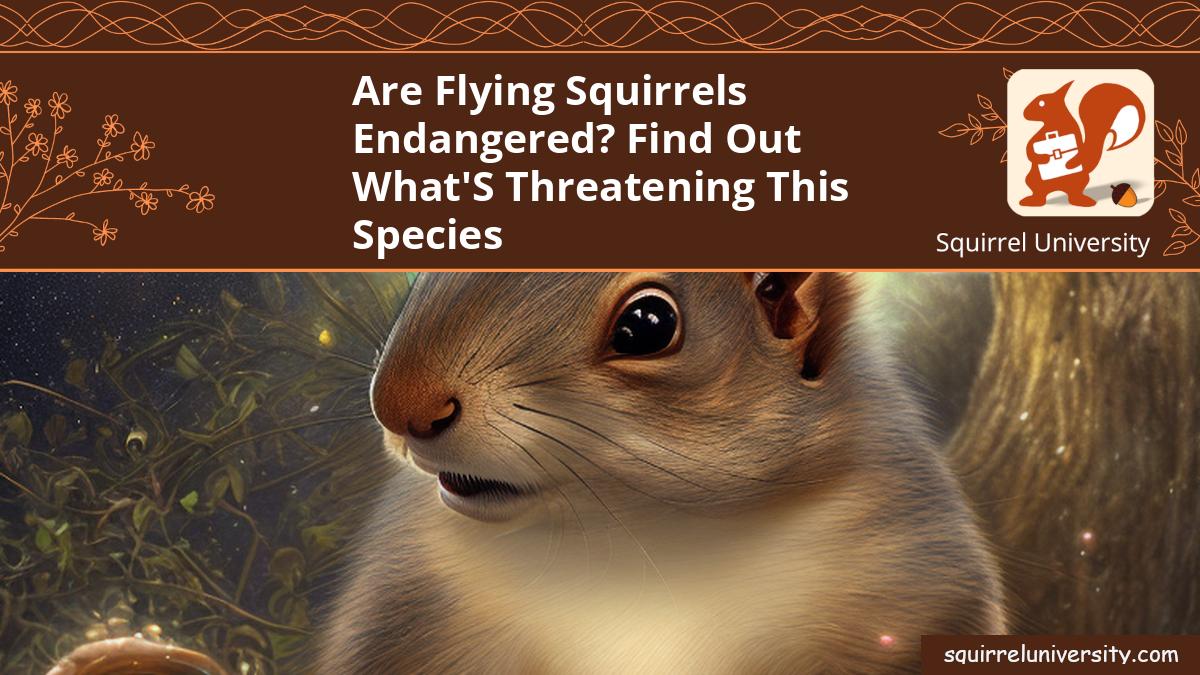As an expert in observing and interacting with squirrels, I have always been intrigued by the Northern Flying Squirrel (Glaucomys sabrinus coloratus). After reading about its endangered status, I was determined to find out more about what is threatening this species. Are Flying Squirrels Endangered? This is a pressing question that needs to be answered.
No, flying squirrels as a species are not endangered. However, one sub-species of flying squirrel, Glaucomys sabrinus coloratus, has been listed on the Endangered Species list since 1985. Conservation efforts have been made to restore its numbers and protect it from becoming extinct.
Are Flying Squirrels Endangered?
In short, flying squirrels are not endangered. However, one subspecies of flying squirrel (Glaucomys sabrinus coloratus) has been on the endangered species list since 1985 and conservation efforts are being made to restore its numbers.
Despite its size, these furry gliders are quite adaptable and can be found in many parts of the world. The two main species of flying squirrels, Northern and Southern, can be found in various parts of North America, Europe, and Asia. The range of both species is fairly large and they even overlap in some areas.
Overview of the Species
There are two main types of flying squirrels: Northern (Glaucomys sabrinus) and Southern (Glaucomys volans). Northern Flying Squirrels inhabit old-growth coniferous forests across Pennsylvania. They are capable of using a variety of forest types including old-growth forests as well as second-growth age class forests that contain a mix of coniferous and deciduous trees.
Southern Flying Squirrels inhabit the same type of forest environment but with greater competition for tree cavities and food sources due to their more aggressive nature. The southern species is also known to carry a parasite that may be debilitating to the northern species.
Northern Flying Squirrel (Glaucomys sabrinus)
The Northern Flying Squirrel (Glaucomys sabrinus) is a small, nocturnal mammal found in old-growth coniferous forests across Pennsylvania. Unfortunately, these animals are under threat from an aggressive competitor – the southern flying squirrel – that carries a debilitating parasite and outcompetes the northern species for resources in mixed coniferous and deciduous forests. With habitat loss and increased competition, the future of this unique species is uncertain.
Southern Flying Squirrel (Glaucomys volans)
The Southern Flying Squirrel (Glaucomys volans) is an aggressive competitor for tree cavities and food resources. They carry a parasite that may be detrimental to their northern counterparts, the Northern Flying Squirrel. With the spread of the parasite, Northern Flying Squirrels may be increasingly at risk of population decline or localized extirpation.
Are Flying Squirrels Endangered?
In short, flying squirrels are not endangered. However, one subspecies of flying squirrel (Glaucomys sabrinus coloratus) has been on the endangered species list since 1985 and conservation efforts are being made to restore its numbers.
Despite its size, these furry gliders are quite adaptable and can be found in many parts of the world. The two main species of flying squirrels, Northern and Southern, can be found in various parts of North America, Europe, and Asia. The range of both species is fairly large and they even overlap in some areas.
Risks to Flying Squirrel Populations
Urban development and logging can both have a huge impact on flying squirrel populations. These activities limit access to the habitats these animals prefer and cause competition from non-native species, leading to a decrease in their numbers.
Subspecies of wildlife such as the northern flying squirrel in Pennsylvania, have been listed as endangered for a long time. However, it does not mean that all of their population is facing similar effects, or will become extinct soon.
Conservation Efforts for Flying Squirrels
State Status
In Pennsylvania, the northern flying squirrel is an endangered species listed under the Wildlife Action Plan, protected under Game and Wildlife Code, and secure nationally. To help prevent their extinction or endangerment other states have implemented their own policies in order to conserve these gliding rodents.
Species Guidance
The Northern Flying Squirrel is an animal that needs protecting, and so this document provides information on identification, life history and how to manage its population. It also explains how potential projects must be screened for potential impacts on them. It’s essential to consult this document when we’re looking to implement conservation strategies concerning these animals, so we can ensure our actions won’t cause more harm than benefit.
Wildlife Action Plan is an important part of any attempt at conserving wildlife populations in North America. It outlines how threatened animal populations should be managed so they remain healthy without negatively affecting other species or natural habitats surrounding them.
Wildlife Action Plan
In an effort to protect the Carolina northern flying squirrel, the Pennsylvania Game Commission (PGC) has developed a Wildlife Action Plan for the species. The plan outlines steps to ensure the preservation of existing habitats and populations, as well as proposed strategies for conservation.
Beginning in 2001, PGC-approved cooperative projects established over 500 nest boxes throughout the state, with over 33 of the observed northern flying squirrels fitted with radio transmitters to track their habits. This research revealed that both the endangered northern species and its aggressive competitor, the southern flying squirrel, share a similar habitat and utilize the same nest boxes. As such, the PGC Board of Commissioners designated the northern flying squirrel as state-endangered in June 2007.
The Wildlife Action Plan recommends further investigation into the precise range and habitat use of this species by conducting regular population monitoring, reproductive trend tracking, and ongoing research into interactions between species. It also calls for protection of hemlock and mixed-stand forests within five miles of known northern flying squirrel populations. Further, nest box monitoring should continue throughout potential and occupied forest stands.
Further Reading and Resources
For those looking to learn more about conservation efforts regarding flying squirrels, there are several resources available online. The Endangered Species Research journal published an article discussing predictive habitat models derived from nest-box occupancy for threatened Carolina northern flying squirrels in the Southern Appalachians. This can provide valuable insight for research teams hoping to gain a better understanding of this species.
FAQ
What is causing southern flying squirrels to become endangered?
Southern Flying Squirrels are in danger of becoming endangered due to a combination of climate change and habitat destruction. Rising temperatures, drought, and other weather changes have caused their natural habitats to become less suitable for them to survive in. In addition, the loss of old-growth forests has further limited their range, leaving them increasingly more vulnerable.
In what parts of the US do flying squirrels inhabit?
Southern flying squirrels are primarily found in the eastern United States, from New England to Florida, west to parts of Texas and Oklahoma. These small, nocturnal rodents inhabit dense wooded areas with heavy vegetation and a variety of hardwood trees. They often make their homes in hollow trees or tree cavities near the ground.
What is the total global population of flying squirrels?
Flying squirrels are a fascinating species that can be found across the globe. Estimates suggest there may be over 10 million of these creatures in existence, with the majority being distributed amongst North America, Europe, and Asia. In the United States alone it is thought that around 500,000 of these animals exist. Although exact numbers are impossible to determine due to their elusive nature.
What illness do flying squirrels have?
Southern Flying Squirrels can carry a variety of diseases, such as Bacterial conjunctivitis (Pink Eye) and Scabies. They may also be carriers for Giardia, a protozoan parasite that affects the digestive tract. In some areas, they are also hosts for ticks and fleas, which can spread Lyme disease, Rocky Mountain Fever, and other illnesses to humans.
Conclusion
Flying squirrels are an integral part of our natural ecosystems and we must work to protect them from becoming endangered. The Northern flying squirrel, Glaucomys sabrinus coloratus, is a species that is currently listed on the Endangered Species list. Conservation efforts have been made to restore its numbers and keep it from being wiped out for good.
Are flying squirrels endangered? For now, it appears that the answer is no. However, conservationists must remain vigilant in order to ensure that this important species does not become extinct. By taking proper action and protecting their habitats, we can ensure that these remarkable creatures remain in our lives for generations to come.
You may also be interested in reading:

